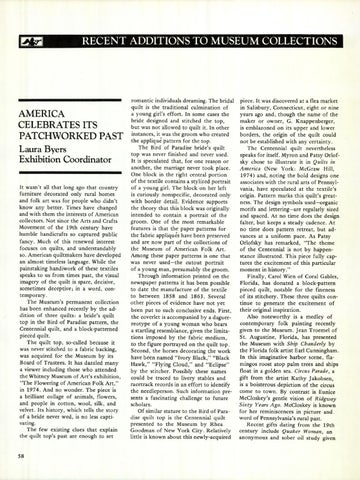G7M
RECENT ADDITIONS TO MUSEUM COLLECTIONS
AMERICA CELEBRATES ITS PATCHWORKED PAST Laura Byers Exhibition Coordinator It wasn't all that long ago that country furniture decorated only rural homes and folk art was for people who didn't know any better. Times have changed and with them the interests of American collectors. Not since the Arts and Crafts Movement of the 19th century have humble handicrafts so captured public fancy. Much of this renewed interest focuses on quilts, and understandably so. American quiltmakers have developed an almost timeless language. While the painstaking handiwork of these textiles speaks to us from times past, the visual imagery of the quilt is spare, decisive, sometimes deceptive; in a word, contemporary. The Museum's permanent collection has been enhanced recently by the addition of three quilts: a bride's quilt top in the Bird of Paradise pattern, the Centennial quilt, and a block-patterned pieced quilt. The quilt top, so-called because it was never stitched to a fabric backing, was acquired for the Museum by its Board of Trustees. It has dazzled many a viewer including those who attended the Whitney Museum of Art's exhibition, "The Flowering of American Folk Art," in 1974. And no wonder. The piece is a brilliant collage of animals, flowers, and people in cotton, wool, silk, and velvet. Its history, which tells the story of a bride never wed, is no less captivating. The few existing clues that explain the quilt top's past are enough to set
58
romantic individuals dreaming. The bridal quilt is the traditional culmination of a young girl's effort. In some cases the bride designed and stitched the top, but was not allowed to quilt it. In other instances, it was the groom who created the applique pattern for the top. The Bird of Paradise bride's quilt top was never finished and never used. It is speculated that, for one reason or another, the marriage never took place. One block in the right central portion of the textile contains a stylized portrait of a young girl. The block on her left is curiously nonspecific, decorated only with border detail. Evidence supports the theory that this block was originally intended to contain a portrait of the groom. One of the most remarkable features is that the paper patterns for the fabric appliques have been preserved and are now part of the collections of the Museum of American Folk Art. Among these paper patterns is one that was never used—the cutout portrait of a young man, presumably the groom. Through information printed on the newspaper patterns it has been possible to date the manufacture of the textile to between 1858 and 1863. Several other pieces of evidence have not yet been put to such conclusive ends. First, the coverlet is accompanied by a daguerreotype of a young woman who bears a startling resemblance, given the limitations imposed by the fabric medium, to the figure portrayed on the quilt top. Second, the horses decorating the work have been named "Ivory Black," "Black Hawk," "Flying Cloud," and "Eclipse" by the stitcher. Possibly these names could be traced to livery stables and racetrack records in an effort to identify the needleperson. Such information presents a fascinating challenge to future scholars. Of similar stature to the Bird of Paradise quilt top is the Centennial quilt presented to the Museum by Rhea Goodman of New York City. Relatively little is known about this newly-acquired
piece. It was discovered at a flea market in Salisbury, Connecticut, eight or nine years ago and, though the name of the maker or owner, G. Knappenberger, is emblazoned on its upper and lower borders, the origin of the quilt could not be established with any certainty. The Centennial quilt nevertheless speaks for itself. Myron and Patsy Orlofsky chose to illustrate it in Quilts in America (New York: McGraw Hill, 1974) and, noting the bold designs one associates with the rural arts of Pennsylvania, have speculated at the textile's origin. Pattern marks this quilt's greatness. The design symbols used—organic motifs and lettering—are regularly sized and spaced. At no time does the design falter, but keeps a steady cadence. At no time does pattern retreat, but advances at a uniform pace. As Patsy Orlofsky has remarked, "The theme of the Centennial is not by happenstance illustrated. This piece fully captures the excitement of this particular moment in history." Finally, Carol Wien of Coral Gables, Florida, has donated a block-pattern pieced quilt, notable for the fineness of its stitchery. These three quilts continue to generate the excitement of their original inspiration. Also noteworthy is a medley of contemporary folk painting recently given to the Museum. Jean Troemel of St. Augustine, Florida, has presented the Museum with Ship Chanderly by the Florida folk artist Earl Cunningham. In this imaginative harbor scene, flamingos roost atop palm trees and ships float in a golden sea. Circus Parade, a gift from the artist Kathy Jakobsen, is a boisterous depiction of the circus come to town. By contrast is Eunice McCloskey's gentle vision of Ridgway Sixty Years Ago. McCloskey is known for her reminiscences in picture and. word of Pennsylvania's rural past. Recent gifts dating from the 19th century include Quaker Woman, an anonymous and sober oil study given
